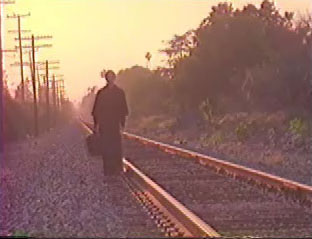C D G Chorus Minnie Dean, Minnie Dean, she's gonna ge'cha |
Sound and Video
|
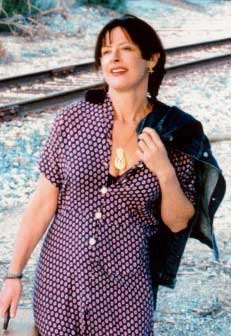
Helen
in a scene from the Bauer video
|
After working for a theatre company in London, she embarked on a singing career, initially fronting covers bands. "I went on tour in Europe singing with a couple of bands. It took me about two tours to realise 'I don't want to do this' so I went back to London, borrowed some money off my mum and dad, and made a demo." She recorded The Sonora Sessions, a 5 track EP which included The Ballad of Minnie Dean.
Her original songs got her work with Ensign Records in London, and then Geffen Records in Los Angeles. She has been in LA ever since, living on advances by the publishing company. "The idea is that your songs will be recorded by other artists," says Helen, "Accruing you royalties. If a big name act picks up your song, you will of course make more money." Condensed from Jennifer Scott's article in The New Zealand Musician, Feb 2001.
Read more about Helen and her songs at her website. She has recently (2003) written two new NZ-inspired songs, Manukau, and Whale.
Minnie Dean
Illegitimate babies
New Zealand's adoption laws came into being in the later 19th century during the Victorian period. The Victorian mindset was that children were parental possessions, and that birthmothers of bastards should be punished.Humiliation of unmarried mothers
Before 1900 illegitimacy was seen as a major threat to public morality. It was unthinkable for Charitable Aid Boards to assist unmarried mothers to keep their babies. Many children ended up in orphanages or industrial schools, others died. The 1907 death rate of illegitimate children was 2.5 times higher than legitimate children. Unmarried mothers faced humiliation in 'Homes for Fallen Women'.Baby farming 1880-1920
This provided quick, confidential disposal of illegitimate children, and hid family shame. For a down payment the baby was taken off their hands with no questions asked and adopted out. The sooner a baby farmer got rid of the child, the greater the profit. Some infants suffered an early demise. Taken from Keith Griffith's article, The History of Adoption in NZ.A young Scottish widow
Minnie Dean was born Williamina McCulloch in 1844, at West Greenock, Renfrewshire, Scotland. She was the fourth in a family of eight girls of Elizabeth Swan and her husband, John McCulloch, an engine driver. She appeared in Invercargill in 1868 as Mrs McCulloch, a widow with two small daughters.She married Charles Dean in 1872, and lived with him on a small farm at Winton, 19 miles north of Invercargill by railway. Minnie set up a baby-farming business, accepting children for adoption in return for payments of £20 or £30. ($4000 to $6000 in NZ today)
Her nefarious activities were revealed in 1895 when an alert railway guard noticed her get onto the Lumsden train with a baby and a hatbox, but get off with only the hatbox. He alerted the police who found railway workers who had carried the box onto the train - when it was light - and from off the train - by which time it was heavy.
Police enquiries
Police enquiries led to a Mrs Hornsby who resided in Dunedin. She told police she had handed over her one-month-old grand-daughter with money to Minnie Dean at Milburn, four miles north of Milton.
Police brought Mrs Hornsby to Dean's residence. There she recognised not only Dean but a piece of baby's clothing belonging to her grand-daughter.
Police searched a recently-dug flowerbed and found two babies' bodies buried, (where the wooden cross is in this contemporary photo.) The search continued and another baby's body was found (where the police are sieving dirt). Dean was charged with the murder of two infants.
Even though Dean was identified by Mrs Hornsby as the woman she gave her grand-daughter to, she denied it, but finally admitted it under duress and with the evidence of the clothes.
Trial and execution
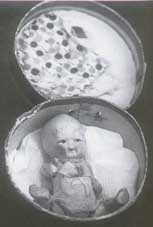 During the trial, miniature hatboxes with baby dolls in them were sold outside the courthouse. (photo)
During the trial, miniature hatboxes with baby dolls in them were sold outside the courthouse. (photo)The verdict was guilty of murder of one baby, although she had probably accounted for over 20 children in this way. The sentence - death by hanging. She is the only woman in New Zealand ever to be hanged by the law.
She was a woman of contradictions. According to folklore, she had killed the other babies with hat pins and had thrown their bodies into streams. But she was also capable of demonstrating warmth and affection to her wards. Letters she wrote to women with children for adoption are charged with religious and benevolent concern.
Most assume that Minnie Dean was both insane and money-fixated. Her unmarked grave is in the cemetery just north of Winton. It is said that nothing will grow on her grave. Condensed from Minnie Dean in Crime.co.nz
Biographies of Minnie Dean
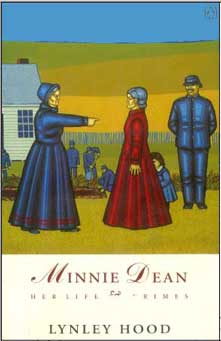
Lynley Hood, Minnie Dean: Her Life & Crimes, Penguin, Auckland, 1994Minnie Dean's business of caring for illegitimate babies was an unwelcome reminder to righteous Victorians that their campaign for the suppression of fornication was a dismal failure.
Was she guilty as charged, or did the weight of public condemnation press heavily enough on the police, the judge and the juries involved to unbalance the scales of justice? Was the Winton baby farmer a mercenary cold-blooded killer? Or a scapegoat sacrificed at the altar of Victorian hypocrisy?
Lynley Hood's book leads the reader through the labyrinth of myths and legends to the real Minnie Dean and raises some disturbing questions. It is far from certain whether the real Minnie Dean deserves her terrible place in New Zealand's folklore.
The Dictionary of New Zealand Biography
There is a shorter on-line biography of Minnie Dean, also by Lynley Hood, at the DNZB website.
The Ballad of Minnie Dean in the Media
Audio recording
Helen Henderson recorded The Ballad of Minnie Dean on The Sonora Sessions, a 5 track EP produced by her own label, Bad Minnie Productions, Los Angeles (2000)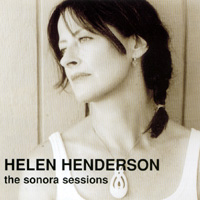
Bauer Video
The song and its story appealed to filmmaker, Rose Bauer, who heard Helen play the song, and they have subsequently filmed a video on 35mm for it.Greenstone Documentary
The song also featured on a Greenstone Pictures TV documentary about Minnie Dean, based on Lynley Hood's biography.
Run the Cutter
And another Minnie Dean ballad has been written by Marylyn Hayes and Brendon Fairbairn.
It is on the Passing time CD, Invercargill, N.Z. 2000, by New Zealand celtic folk music group Run the Cutter.- Run the cutter
- Six Mile Beach
- Ross's jig
- Minnie Dean
- General Grant (ship wrecked with gold on board)
- A glance at Tokanui (mental hospital)
- Delivering Hokonui
- Chunuk Bair (soldiers at Anzac)The Ballad Writers' Toolbox
- In Her Hat Box
- The Ballad of Minnie Dean is an good example of the Lights, Camera, Action! method of writing a story-ballad (revise that method here).
Helen has constructed these verses like the story board of a short film.
- She has started by getting straight into the action.
- ...with a series of "camera shots"- a vivid opening image (woman in black) - a panning shot (across to the station platform) - dialogue (She's goin'ta get you...) - a close-up (wrapping up the little one) - action (here lie the children) - the climax (in the courthouse).
- She has jumped quickly from scene to scene...
- describing two or three details so vividly that the audience feel they can really see everything. (The hatbox, the baby-buying, the demented defence in court)
- She has used direct speech.
- No need to identify the speaker. ("You'd better be good..." -obviously an Invercargill mother)
- She has repeated the key scene containing the main action.
- ...but with a significant change in meaning.
- Dressed in black - to the early morning station - and on her way back...
- Dressed in black - to the early morning courthouse - and never comes back...
- And she constructed this 'film storyboard' so vividly, that Rose Bauer did make a film of it!
Main Song List - Home
December 2001, published on web.
Nov 2003, up-dated and MP3 links added.
Aug 2006, font changed.
Oct 2025, modified for small screens and counter started.
powered by Free-Counters.org
